Magical And Malicious Creatures That Prey Upon Yggdrasil In Norse Beliefs
A. Sutherland - AncientPages.com - There are many shrines in Asgard and Midgard, but most sacred of all is Yggdrasil, the largest of all trees. The branches spread all over the world and reach the sky.
The tree grows thanks to three deep roots. One of the roots goes under Asgard, the other under Jotunheim, where the empty swallow, Ginungagap - primordial void - once existed in the old days.
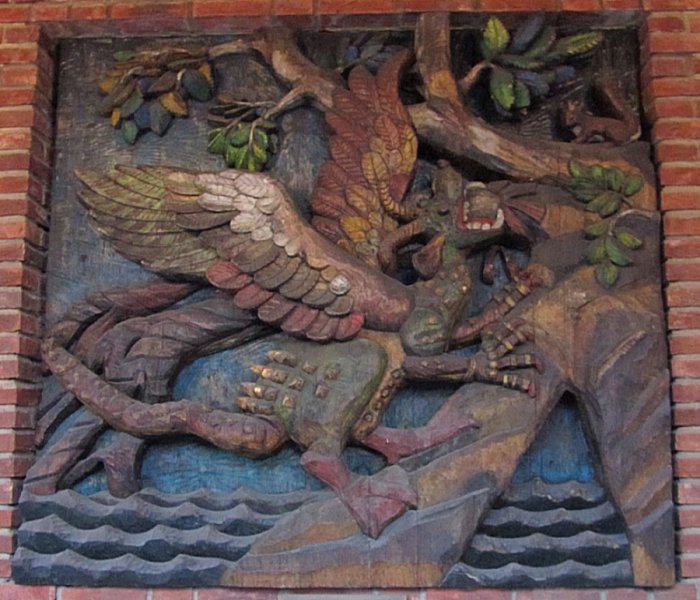 Nidhogg (and other creatures) is gnawing at the root of the sacred tree Yggdrasil. Photo credit: Eir Torvik / Rådhusets forvaltningstjeneste (City Hall General Services)
Nidhogg (and other creatures) is gnawing at the root of the sacred tree Yggdrasil. Photo credit: Eir Torvik / Rådhusets forvaltningstjeneste (City Hall General Services)
Ginungagap separated Nifelheim, the fog world from the southern part of Muspelheim, the land of primordial fire and flames.
The third root extends over the realm of death in Niflheim, the most inhospitable and darkest world of the densest mists and fogs. It was the first of the nine worlds created within Yggdrasil and located to the north of the great plain of Ginnungagap.
Under these roots, there is a place for a fearsome well, Hvergelmer (in Old Norse "bubbling boiling spring"), attested in Snorri Sturluson’s Poetic Edda. In Norse mythology, Hvergelmer is a spring that runs past the northern root of the sacred Yggdrasil and then divides into eleven ice-cold rivers. From there it’s very close to the frost giants that threatened the world with eternal winter.
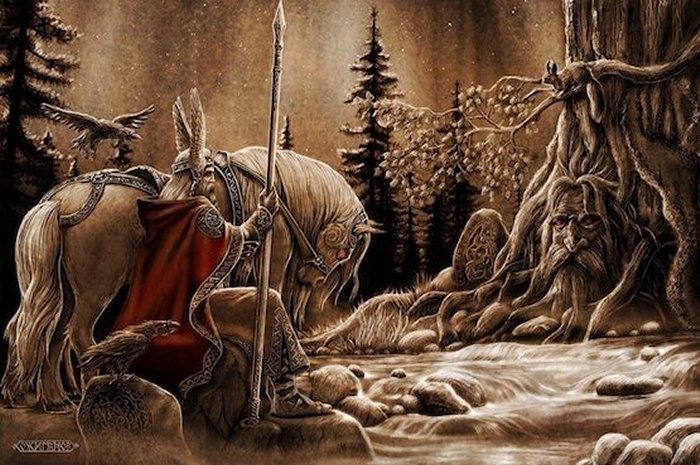 Many visitors come and ask for a drink but at first, they have to provide a sacrifice of some kind.
Many visitors come and ask for a drink but at first, they have to provide a sacrifice of some kind.
In Jotunheim, the giant Mimir (“The Wise One") has the well filled with knowledge, wisdom, and understanding in the world. Mimir owns the well and drinks its water. Both the well and Mimir’s abode are located beneath the second root of Yggdrasil, the World Tree. Mimir guards the well, drinks from it on a daily basis and gains his wisdom from this source. He also feeds Yggdrasil daily on the waters from his well.
Below the third root that reaches the Asgard (Asgård) lies the very sacred Well of Urd. At this well, where the branches of Yggdrasil drip honeydew, the gods gather every day to hold their assembly, to discuss urgent problems and to settle disputes.
Urd (Fate), Verdandi (Being), and Skuld (Necessity), who are the three most important among the Norns, the goddesses of destiny, also live beneath the Yggdrasil and beside the Urd’s Well. Every day the three Norns water the tree with pure water and whiten it with clay from the spring, so Yggdrasil can survive and flourish.
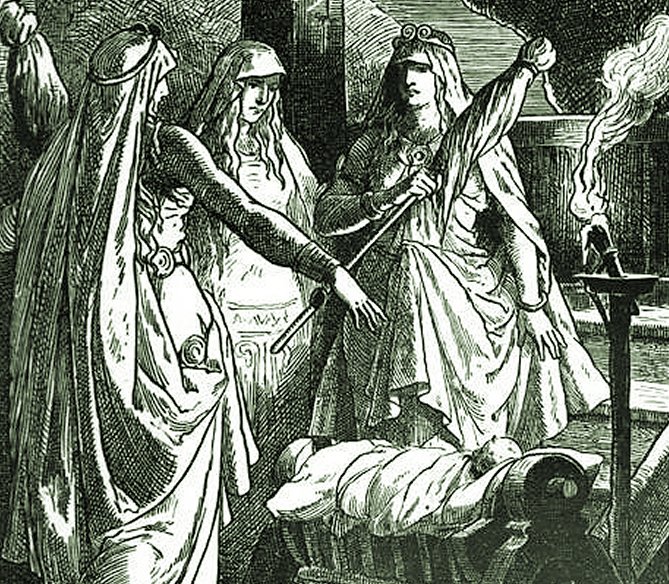 The Norns (1889) by Johannes Gehrts. Public Domain
The Norns (1889) by Johannes Gehrts. Public Domain
The Norns rule the fate of all men and even of the Aesir gods themselves. They direct the unchallengeable laws of the universe as well. When a child is born, the goddesses of destiny determine the child’s fate.
A certain runic inscription, carved on a piece of wood and discovered in the historic Borgund Stave Church in Borgund in Western Norway, says:
“The Norns determine good and bad things and they have brought great sorrow to me.” The inscription was also interpreted as follows:
“The Norns have done both good and evil.”
Urd, Verdandi, and Skuld are very powerful beings that decide the good and evil of life, but they are not the only ones. There are many others and their rules must be followed because no one lives one day longer than the Norns grant him or her.
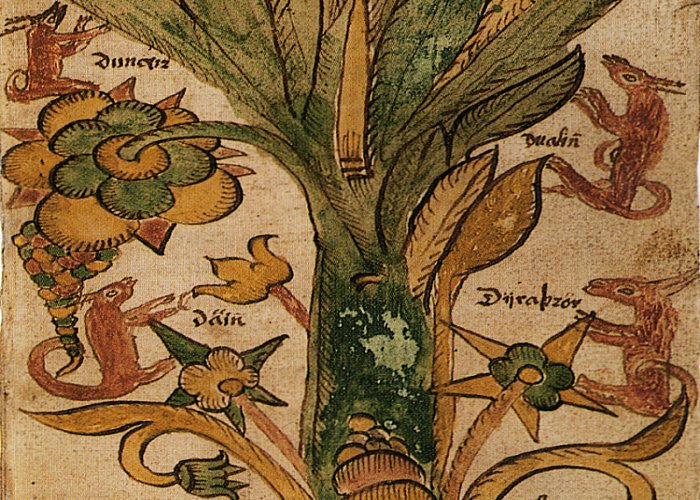 This drawing made by a 17th-century Icelander shows the four stags on the World Tree. Neither deer nor ash trees are native to Iceland. Public Domain
This drawing made by a 17th-century Icelander shows the four stags on the World Tree. Neither deer nor ash trees are native to Iceland. Public Domain
The fascinating world of the sacred Yggdrasil has many animals that dwell among its branches such as a wise eagle, Hræsvelgr (Räsvelg) known as "Corpse Swallower", in Old Norse), a hawk, four stags, Nidhogg, a terrible snake, and the little Ratatoskr. They are evil residents of Yggdrasil that wish to destroy the sacred tree. Four deer run around the branches of the ashes and bite off the young shoots. The snake Nidhogg (Nidhögg), a corpse-eating dragon lives entwined around Yggdrasil’s foot and is busy with stalking in the roots of Yggdrasil.
See also:
Skadi: Goddess Of Destruction, Giantess And Patron Of Winter Hunters And Skiers In Norse Mythology
Death Of Kvasir And How Famous Mead Of Poetry Was Created, Stolen And Finally Recovered By Odin
War Between The Aesir And The Vanir Gods In Norse Mythology
His plan is to kill the tree because he knows that its death would be signal the end of the gods.
At the topmost of the World Tree, an eagle is sitting in the topmost branches, flapping its wings and creating the winds in Midgard, the realm of humans. A hawk Vedfolnir (Vedrfolner), attested in Snorri’s Poetic Edda and Prose Edda, is the one who is pale by wind and weather; he sits on the eagle’s forehead between his eyes.
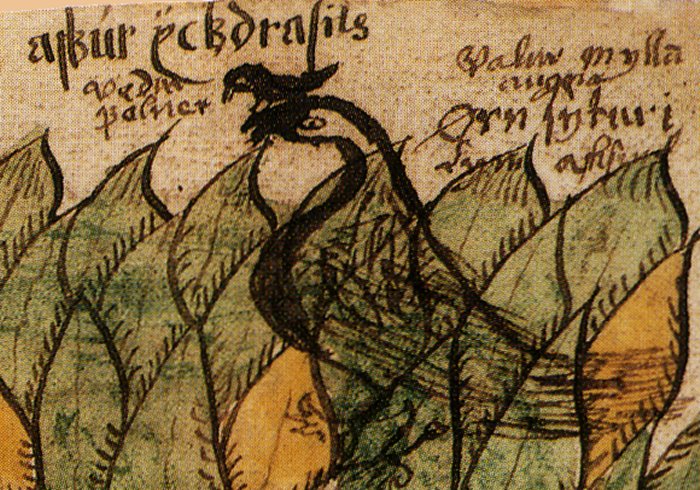 A 17th-century Icelandic manuscript shows a hawk, Veðrfölnir, on top of an eagle on top of a tree, Yggdrasil. Public Domain
A 17th-century Icelandic manuscript shows a hawk, Veðrfölnir, on top of an eagle on top of a tree, Yggdrasil. Public Domain
Ratatoskr, also an important inhabitant of Yggdrasil, spreads gossips and carries insults between Nidhogg and an eagle, a giant who takes the form of an eagle.
Other enemies of Yggdrasil involve Dain, a fully grown male deer, or stag, that lives among the branches of Yggdrasil, and eats its leaves. The other three stags are Duneyr, Durathror, and Dvalin, which also gnaw Yggdrasil’s leaves and branches. Not any of them is a friend of the tree.
See also: More Myths And Legends
The four stags are mentioned in the story of Yggdrasil told in Griminismal, part of the Poetic Edda, and retold by Snorri in Gylfaginning.
Despite many enemies, evergreen Yggdrasil stands over the Well of Urd, the Honeydew that falls from its leaves gives nourishment to the bees. The tree has a vitality which makes it stand tall and strong at all times.
Written by – A. Sutherland - AncientPages.com Senior Staff Writer
Copyright © AncientPages.com All rights reserved. This material may not be published, broadcast, rewritten or redistributed in whole or part without the express written permission of AncientPages.com
Expand for referencesReferences:
Viking, Tidskrift for Norroen Arkeologi
Lindow, J. Norse Mythology
Davidson, H. E. Gods and Myths of Northern Europe
More From Ancient Pages
-
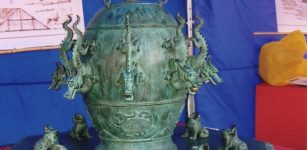 Zhang Heng Seismograph Could Record Earth’s Dangerous Movements
Artifacts | Mar 8, 2023
Zhang Heng Seismograph Could Record Earth’s Dangerous Movements
Artifacts | Mar 8, 2023 -
 Unusual Parcel With 500-Year-Old Horn Container Discovered In South Africa Sheds Light On Pre-Colonial Khoisan Medicines
Featured Stories | Feb 15, 2023
Unusual Parcel With 500-Year-Old Horn Container Discovered In South Africa Sheds Light On Pre-Colonial Khoisan Medicines
Featured Stories | Feb 15, 2023 -
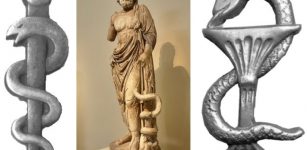 Why Is A Snake Symbol Of Medicine And Pharmacies?
Ancient History Facts | Jan 15, 2018
Why Is A Snake Symbol Of Medicine And Pharmacies?
Ancient History Facts | Jan 15, 2018 -
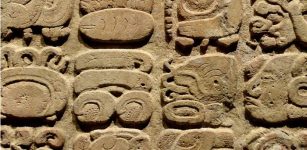 On This Day In History: Spanish Priest Diego de Landa Burned The Sacred Books Of Maya – On July 12, 1562
News | Jul 12, 2016
On This Day In History: Spanish Priest Diego de Landa Burned The Sacred Books Of Maya – On July 12, 1562
News | Jul 12, 2016 -
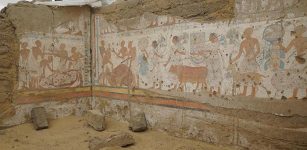 Tomb Of Pharaoh Ramesses II Treasurer Ptah-M-Wia Discovered In Saqqara
Archaeology | Nov 4, 2021
Tomb Of Pharaoh Ramesses II Treasurer Ptah-M-Wia Discovered In Saqqara
Archaeology | Nov 4, 2021 -
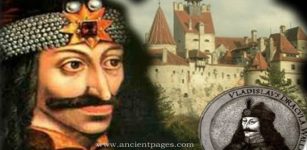 Dracula: Cruel, Ruthless And Bloodthirsty Ruler But Not A Vampire
Featured Stories | Sep 12, 2023
Dracula: Cruel, Ruthless And Bloodthirsty Ruler But Not A Vampire
Featured Stories | Sep 12, 2023 -
 Dozens Of Unique 2,500-Year-Old Ceremonial Treasures Discovered In A Drained Peat Bog
Archaeology | Jan 27, 2023
Dozens Of Unique 2,500-Year-Old Ceremonial Treasures Discovered In A Drained Peat Bog
Archaeology | Jan 27, 2023 -
 Indian Black Earth And Biodiversity Of The Amazon – New Study
Archaeology | Jun 24, 2020
Indian Black Earth And Biodiversity Of The Amazon – New Study
Archaeology | Jun 24, 2020 -
 Hogmanay: Scotland’s New Year Celebration Inherited From The Vikings
Ancient Traditions And Customs | Dec 31, 2024
Hogmanay: Scotland’s New Year Celebration Inherited From The Vikings
Ancient Traditions And Customs | Dec 31, 2024 -
 19 Cannons Shot From British Ships During The American Revolution Discovered In Savannah River
Archaeology | Apr 29, 2022
19 Cannons Shot From British Ships During The American Revolution Discovered In Savannah River
Archaeology | Apr 29, 2022 -
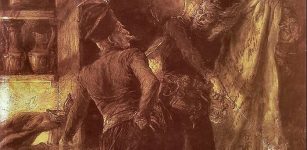 Pan Twardowski – The Man Who Sold His Soul To The Devil In Exchange For Special Powers
Featured Stories | Aug 12, 2021
Pan Twardowski – The Man Who Sold His Soul To The Devil In Exchange For Special Powers
Featured Stories | Aug 12, 2021 -
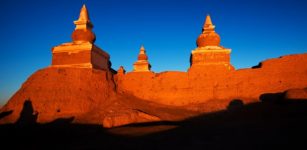 Khara-Khoto ‘Black City’ – Besieged By Genghis Khan But Flourished Under Mongol Rule
Featured Stories | May 13, 2021
Khara-Khoto ‘Black City’ – Besieged By Genghis Khan But Flourished Under Mongol Rule
Featured Stories | May 13, 2021 -
 Ancient Mesopotamian City Lagash Reveals More Archaeological Secrets
Archaeology | Jan 25, 2023
Ancient Mesopotamian City Lagash Reveals More Archaeological Secrets
Archaeology | Jan 25, 2023 -
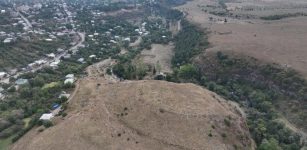 Why Was The Dmanisis Gora Fortress Community So Resilient In The Transition From The Bronze To Iron Age
Archaeology | Jun 5, 2023
Why Was The Dmanisis Gora Fortress Community So Resilient In The Transition From The Bronze To Iron Age
Archaeology | Jun 5, 2023 -
 On This Day In History: Statue Of Venus de Milo Is Discovered On The Aegean Island Of Milos – On Apr 8, 1820
News | Apr 8, 2016
On This Day In History: Statue Of Venus de Milo Is Discovered On The Aegean Island Of Milos – On Apr 8, 1820
News | Apr 8, 2016 -
 Excavations In Keezhadi, Tamil Nadu, India Shed Light On Life During Sangam Age
Artifacts | Aug 24, 2015
Excavations In Keezhadi, Tamil Nadu, India Shed Light On Life During Sangam Age
Artifacts | Aug 24, 2015 -
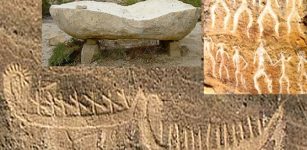 Gobustan’s Petroglyphs And Yalli Dancers’ Amazing Musical Stone
Featured Stories | May 29, 2023
Gobustan’s Petroglyphs And Yalli Dancers’ Amazing Musical Stone
Featured Stories | May 29, 2023 -
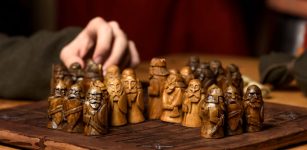 Hnefatafl: Ancient Viking Board Game “King’s Table” Popular In Medieval Scandinavia
Ancient History Facts | Mar 20, 2016
Hnefatafl: Ancient Viking Board Game “King’s Table” Popular In Medieval Scandinavia
Ancient History Facts | Mar 20, 2016 -
 On This Day In History: ‘Bloody Sunday’ In Northern Ireland – On Jan 30, 1972
News | Jan 30, 2017
On This Day In History: ‘Bloody Sunday’ In Northern Ireland – On Jan 30, 1972
News | Jan 30, 2017 -
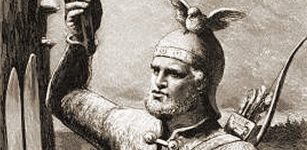 Ullr – Famous Norse Archer – God Of Asgard And Fastest Skier Ever Known Who Taught People The Art
Featured Stories | Jan 10, 2020
Ullr – Famous Norse Archer – God Of Asgard And Fastest Skier Ever Known Who Taught People The Art
Featured Stories | Jan 10, 2020
